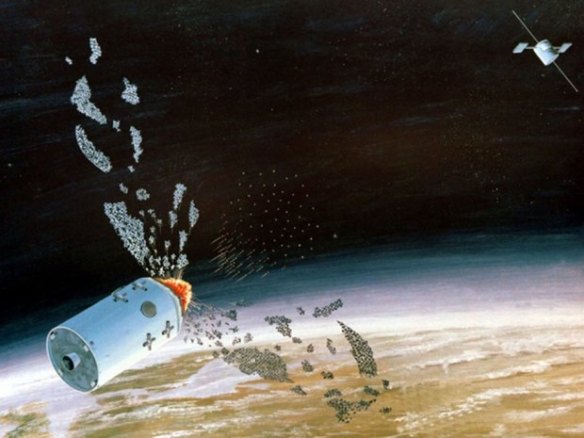
An artist’s conception of a Soviet anti-satellite weapon destroying a satellite in 1984.
The Russian satellite destroyer known as ‘Istrebitel Sputnikov‘ (IS). Carrying an explosive charge, it would be guided on an intercept course towards enemy satellites.
America’s ability to gather intelligence on Soviet developments was severely limited during the early post-war years and the only methods of aerial observation available were large numbers of camera-equipped balloons and specialised spyplanes. The balloons were uncontrollable, unreliable and generated serious diplomatic problems, while the high-altitude reconnaissance flights ended on 1st May 1960 when a Lockheed U-2 was shot down and the pilot captured. There was now intense pressure on US defence contractors to provide the USAF and CIA with a reconnaissance satellite system, and there was an equal determination within the Soviet Union to counter US satellite observation of its activities. Vladimir Chelomei is generally credited within Russia as being the first designer to suggest the idea of an anti-satellite system using another small space vehicle carrying an explosive charge. His initial proposal for an Istrebitel Sputnikov (IS – Destroyer of Satellites) was made in 1959. This small vehicle would be directed towards the target from the ground before it switched to its own terminal guidance system.
In early 1960 Khrushchev approved development of the UR-200 ballistic missile which Chelomei had suggested as the launcher for his IS satellite destroyer, and a decision to proceed with the IS was approved in early 1961. This project was assigned to Anatoly Savin and his deputy K. A. Vlasko-Vlasov, who ran a group within OKB-52 called KB-1. Much of the work on the IS appears to have been compartmentalised and classified as top secret. As the first prototypes neared completion in 1963, there were still problems with developing the UR-200 and a formal request was made via official channels to secure the use of R-7 launch vehicles for testing. The first two prototype test vehicles, named Polet (Flight), were launched on 1st November 1963 and 12th April 1964. Both lacked radar and infrared homing systems but successfully demonstrated orbital manoeuvring capabilities. But the UR-200 missile intended to launch IS still proved very troublesome and after the second test it was cancelled. However, the Ministry of Defence was sufficiently impressed with IS to recommend that the launch vehicle should be replaced by an R-36 missile (SS-9 NATO Scarp) then under development by OKB-586. This resulted in OKB-586 receiving a formal request in August 1965 to develop a suitable version of the R-36 as an IS launcher, and the new slightly modified design was designated 11K67 (and later Tsyklon-2A).
The test launch of this rocket carrying the third prototype IS vehicle took place at Baikonur on 27th October 1967 and was judged to have been a success. Named Cosmos- 185, the IS spacecraft initially entered a 339 x 229 mile (546 x 370km) orbit with a 64.1° inclination, which was later boosted to a 550 x 324 mile (888 x 522km) orbit. During April 1968 another IS vehicle was launched at Baikonur as Cosmos-217, although something went wrong with this test and the IS failed to separate from the upper stage. Six months later Cosmos-248 was launched into orbit at Baikonur as a large target satellite for a fullscale test of the IS vehicle’s capability. Within a matter of hours Cosmos-249 had been launched which was a fully equipped IS vehicle. Cosmos-249 attained a 157 x 84 mile (254 x 136km) orbit and manoeuvred to pass within close proximity of Cosmos-248. A small explosive charge was then detonated to demonstrate the system, although the target vehicle is thought to have remained largely undamaged.
Less than two weeks later another IS vehicle designated Cosmos-252 was launched and successfully intercepted Cosmos-248. The spacecraft exploded within close proximity of the satellite and it was completely destroyed. Although the IS system was still in its early test phase, it seems reasonable to conclude that these trials were considered very successful. Further launches took place during 1969 and 1970 with the orbital apogees of the vehicles increasing to more than 1,242 miles (2,000km) before descent to the target. During 1971 several target satellites designated DS-P1-M were launched from Plesetsk and ASAT trials continued until 1972 when SALT 1 was signed. However, it seems that the Soviet anti-satellite system was considered semi-operational by this time.
Tests resumed in 1976, possibly as a response to military proposals for the US Shuttle which the Soviets perceived as an offensive weapon. It was also clear that the capability and accuracy of the IS system continued to improve. Development of this programme proceeded rather erratically until 1983 when Chairman Yuri Andropov decided to halt further ASAT trials for political reasons. Although ASAT research continued and the Polyus orbital platform was built and unsuccessfully launched in 1987, no further tests were undertaken. Just how far the US went with attempts to duplicate the Soviet IS system remains unknown, but Project SAINT may have been conceived as a direct response to IS.